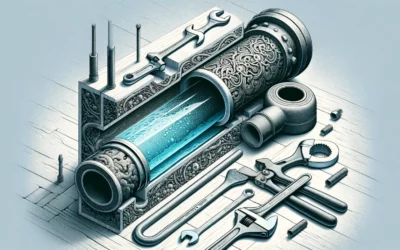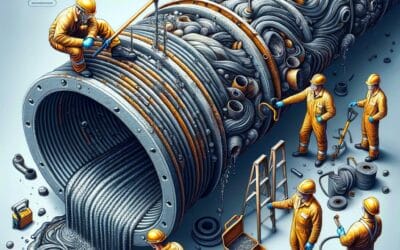Welcome to a highly informative piece, titled “Understanding Why Roots Invade Your Sewer Line: An Expert’s Insight”. As we plunge into the roots of this widely encountered problem, we aim to arm you with an in-depth understanding of why roots infiltrate your sewer lines. In this post, we’ll explore the reasons behind this invasion from a scientific perspective grounded in professional experience and research. With easy-to-grasp explanations, diagrams and expert opinions, this post will not only enlighten you on the ‘why’ but also provide helpful insights to prevent such incidents, ensuring the longevity of your sewer system. So, join us on this educational journey that promises to be beneficial for every household or property owner that wants to avoid costly and stressful sewer line troubles.
Introduction to Root Invasion in Sewer Lines
Root intrusion into sewer lines is significantly more than a mere nuisance; it is a serious problem that can lead to extensive damage and costly repairs if not addressed in time. At the heart of the issue is the simple fact that trees, in their eternal quest for nutrient-rich water, are powerfully drawn to the plentiful supply available within sewer lines. They cleverly infiltrate the smallest cracks and joints in the piping, and once inside, they multiply, blocking up the pipe and potentially causing breakage and collapse.
The particularly insidious character of this problem is its tendency to develop quietly over time, often unnoticed until a major problem comes to light. Understanding the causes and preventive measures can spare homeowners from the frustrations and expenses associated with possible catastrophic sewer line replacement. Two main reasons for root invasions are aging pipes and the presence of trees or shrubs near the sewer line. Aging pipes are more prone to cracks and leaks which roots can exploit to gain entry. On the other hand, the closer trees or shrubs are planted to a sewer line, the more likely their roots will find their way into it.
| Preventative Measures |
| Regular inspection of the sewer line |
| Proper maintenance and servicing of your piping system |
| Implementing root barriers between trees and sewer lines |
These are proven strategies to help curb root invasion into your sewer line. Remember, proactive steps are always better than reactive repairs.
Identifying the Primary Causes of Roots in Sewer Lines
In understanding why roots invade your sewer lines, it’s crucial to identify their primary causes. Firstly, trees and shrubs, if planted near sewer lines, have roots that naturally grow towards these lines in search of water and nutrients, leading to potential blockages. Secondly, cracks and leaks in your sewer pipe create moisture that attracts tree roots towards the pipe, where they then proliferate and cause damage.
Age and material of the sewer line also contribute significantly to the occurrence of root infestation. Older sewer lines, typically those made from clay or concrete, are more prone to breeches from tree roots. Furthermore, climate and location are key factors. In regions with less rainfall, trees will expand their root system in search of water, possibly reaching out to your sewer line. Let’s capture those causative factors in the table below:
| Cause | Explanation |
|---|---|
| Trees and shrubs | Their roots naturally grow towards sewer lines as a source of water and nutrients. |
| Cracks and leaks | These attract tree roots towards your sewer pipe, where they can cause damage. |
| Material and age of the sewer line | Older sewer lines, typically those made from clay or concrete, are more susceptible to root intrusion. |
| Climate and location | In areas with less rainfall, trees may extend their roots in search of water, possibly towards sewer lines. |
To prevent roots from infiltrating your sewer line, consider planting trees and shrubs away from the line, upgrading to modern sewer line materials that resist root intrusion, and monitoring regularly for leaks or cracks. Awareness of these primary causes and taking appropriate preventative measures can save you much distress and financial loss in future.

Pathways Through Which Roots Infiltrate the Sewer Line
The invasion of roots into your sewer line is often the result of their search for moisture and nutrients, as well as the presence of fractures or cracks in the pipes. As an unwelcome byproduct of this, you end up with blocked or damaged pipes. There are two main : Direct Penetration and Indirect Penetration. Direct Penetration occurs when roots find their way to your sewer line through the joints of the pipes. In the past, sewer lines were made up of sections of clay, concrete or metal pipes. The joints in such installations weren’t always perfectly sealed, presenting a perfect avenue of infiltration for determined roots in search of nutrients and water.Indirect Penetration, on the other hand, takes place when roots causing pressure build-up, find a weak spot in the pipe, typically a crack or a hole, and force their way in.
| Penetration Type | Explanation |
|---|---|
| Direct Penetration | Roots infiltrate through unsealed joints or gaps in the pipe sections. |
| Indirect Penetration | Roots impose pressure on weak spots in the pipe, infiltrating through cracks or holes. |
Thanks to technological advancements, many modern pipelines are now being constructed from seamless materials, such as plastic or cast iron. Despite this, even these stronger, seamless pipes can still be compromised by a persistent root system, especially if the installation has been compromised or damaged in any way. Understanding these pathways and ensuring your sewer line is well-protected is vital in maintaining the longevity and functionality of your plumbing system.
The Impact of Root Invasion on Your Sewer System
When it comes to understanding the impact of root invasion on your sewer system, it’s important to realize that tree roots act like a natural plumbing system, drawing water and nutrients from the ground to nourish the tree. Tree roots can travel long distances in search of water, and sometimes these roots can penetrate the walls of your sewer pipes, leading to a blocked or damaged sewer line. This process occurs as tree roots detect the presence of water and nutrients in the sewer line, which then attract the roots, leading to their intrusion in the form of root masses.
The repercussion of such invasions are manifold and can cause severe damages. Tree roots can invade sewer lines in different ways. Among the consequences are:
- Pipeline Blockage: When tree roots enter your sewer pipes, they can create a blockage that results in slow-draining sinks and tubs, toilets that don’t flush properly, and a foul smell emanating from your drains.
- Pipe Collapse: As tree roots continue to grow within your pipes, they can exert pressure on the pipe walls and eventually cause them to crack or collapse.
- Sewage Backups: Blocked pipes can cause sewage to back up into your home, resulting in significant damage and creating a challenging, messy clean-up project.
As you can imagine, these root invasions can lead to costly repairs. Therefore, it is vital to take preventive measures and regularly inspect your sewer system.
| Symptoms of Root Invasion | Corrective Measures |
|---|---|
| Slow flowing drains | Regular Drain Cleaning |
| Recurring drain clogs | Professional Pipe Inspection |
| Foul smell from drains | Immediate Plumbing Repair |
By recognizing the signs of a root invaded sewer line and proactively addressing the problem, you can save yourself from the stress and cost associated with major sewer repairs. Always remember: when it comes to tree root invasion, prevention is better than cure.

Understanding the Signs of Root Invasion in Your Sewer
Have you ever considered the damage an invading root system can do to your sewer line? This common issue is more than just a nuisance—it can lead to expensive repairs and potential health hazards. The first and most important step in addressing this issue is recognizing the signs of root invasion. Excessive moisture around your property, slow drains, and foul odours emanating from your drains or toilets are clear tell-tale signs of potential problems. Also, if you hear gurgling sounds from your toilets or drains, it might be time to call a professional plumber.
By understanding why these problems occur, you can enact preventive measures and potentially save lots of time and money. In general, root invasion happens when tree or shrub roots find their way into your sewer pipe in search of water and nutrients. The roots usually enter through small cracks, holes or pipe joints, and once inside, they thrive and expand, causing blockage and damage. Below is a table that lists some common signs of root invasion in your sewer line.
| Sign | Description |
|---|---|
| Gurgling noises | Sounds coming from your drains or toilets. |
| Slow drainage | Water draining slower than usual from your sinks and bathtubs. |
| Foul Odour | Unpleasant smell coming from your drains or toilets. This is usually a sign of a blocked or damaged pipe. |
| Excessive moisture | Extra damp or lush patches of your garden or lawn. These areas might be receiving extra water service from a broken sewer line. |
Methods to Prevent and Remove Roots in Your Sewer Line
Your sewer line can take quite a beating from roots. Over time, they can grow into these pipes, causing major plumbing problems. Understanding ways to prevent and eliminate these roots can be crucial in preventing costly repairs.
Let’s talk specifics. Firstly, maintaining a regular schedule of sewer line inspections is key. This allows for early detection and taking immediate action before a minor root intrusion grows into a significant blockage. Additionally, consider root barriers, which are physical obstructions planted around your sewer lines to ward off root invasion. Other measures include the application of root-killing chemicals, but be sure to use eco-friendly options.
- Sewer line inspection: Regular inspection allows for immediate detection and action, thus preventing major damages.
- Root barriers: The use of physical obstructions around your sewer pipes can prevent root invasion.
- Root-killing chemicals: These, especially the eco-friendly options, can effectively kill and prevent the regrowth of roots.
If you discover roots in your sewer line, prompt removal is crucial. Hydro-jetting is an effective method that uses a high-pressure water jet to force roots out of the pipeline. Another method is using a mechanical auger—a plumbing snake with cutting blades—to slice through the roots. The only caveat is the potential damage to old or fragile sewer lines.
| Method | Description | Note |
|---|---|---|
| Hydro-jetting | Utilizes a high-pressure water jet to expel roots from the pipeline | Considered highly effective; however, not recommended for weak or fragile pipes |
| Mechanical Auger | Uses a plumbing snake fitted with cutting blades to slice through roots | Effective but may potentially damage older or fragile sewer lines |
In essence, maintaining an understanding of why roots invade your sewer lines and knowing how to handle them when they do will go a long way in preserving the integrity of your home’s plumbing system. Remember, when it comes to sewer lines, prevention is always the best solution.

Wrap-Up: Protecting Your Sewer System from Future Root Invasion
In conclusion, preserving the integrity of your sewer system and protecting it against future root incursions can be achieved by undertaking a combination of maintenance and preventative measures. It’s crucial to routinely inspect your sewer lines if you have many trees in your vicinity. Availing the services of professional plumbers for an annual inspection can help detect issues early and save you from expensive repairs.
Here are some proactive steps you can take to safeguard your sewer system:
- Regular Cleaning: This not only includes the sewer lines but also the pipeline from your household to the public sewer.
- Root Barriers: Installing physical barriers, usually made of plastic or fabric, can deter roots from getting too close to your sewer lines.
- Sewer-safe Landscaping: Opting for plants and trees with shallow root systems can minimize the risks of root invasion.
- Chemical Root Killer: Available at hardware stores, these chemicals can effectively discourage root growth into sewer lines.
Here is a comparison of the four methods and the roles they play:
| Method | Role |
|---|---|
| Regular Cleaning | Prevents accumulation of waste that attracts roots |
| Root Barriers | Act as a physical shield around sewer lines |
| Sewer-safe Landscaping | Manages root growth through careful plant selection |
| Chemical Root Killer | Controls invasive root growth via chemical means |
By integrating the above mentioned preventative measures, you can minimize the likelihood of a root invasion, ensuring a healthy sewer system with optimal functionality. Remember, securing a root-free sewer system is a worthy investment for your home’s long-term welfare.
To Conclude
In concluding, understanding why roots invade your sewer line can greatly help in preventing future problems. Essentially, roots stretch out in search of moisture and nutrients, and the snug confines of your sewer line serve as an attractive bountiful, continuous source for them. When left unattended, this natural occurrence will not only disrupt your sewage system but also pose a costly and inconvenient problem. As an expert in the field, I hope that the insights shared in this article have been able to help you understand the reasons behind the challenge and make better-informed decisions in managing your sewer systems. Always remember, prevention is a lot easier and more cost-effective than cure. Regular inspection of your sewer lines can save you money, effort, and time in the long run. Managing this issue is indeed simpler now that we know the causes and the preventive measures. We encourage you to utilize this knowledge to maintain the health of your pipes, yard and overall sewer system. Let our insights serve as your guide toward a more efficient and problem-free home environment. Stay informed and stay ahead of the game. Until next time, here’s to a trouble-free sewer line and a safe, healthy living environment for all.









